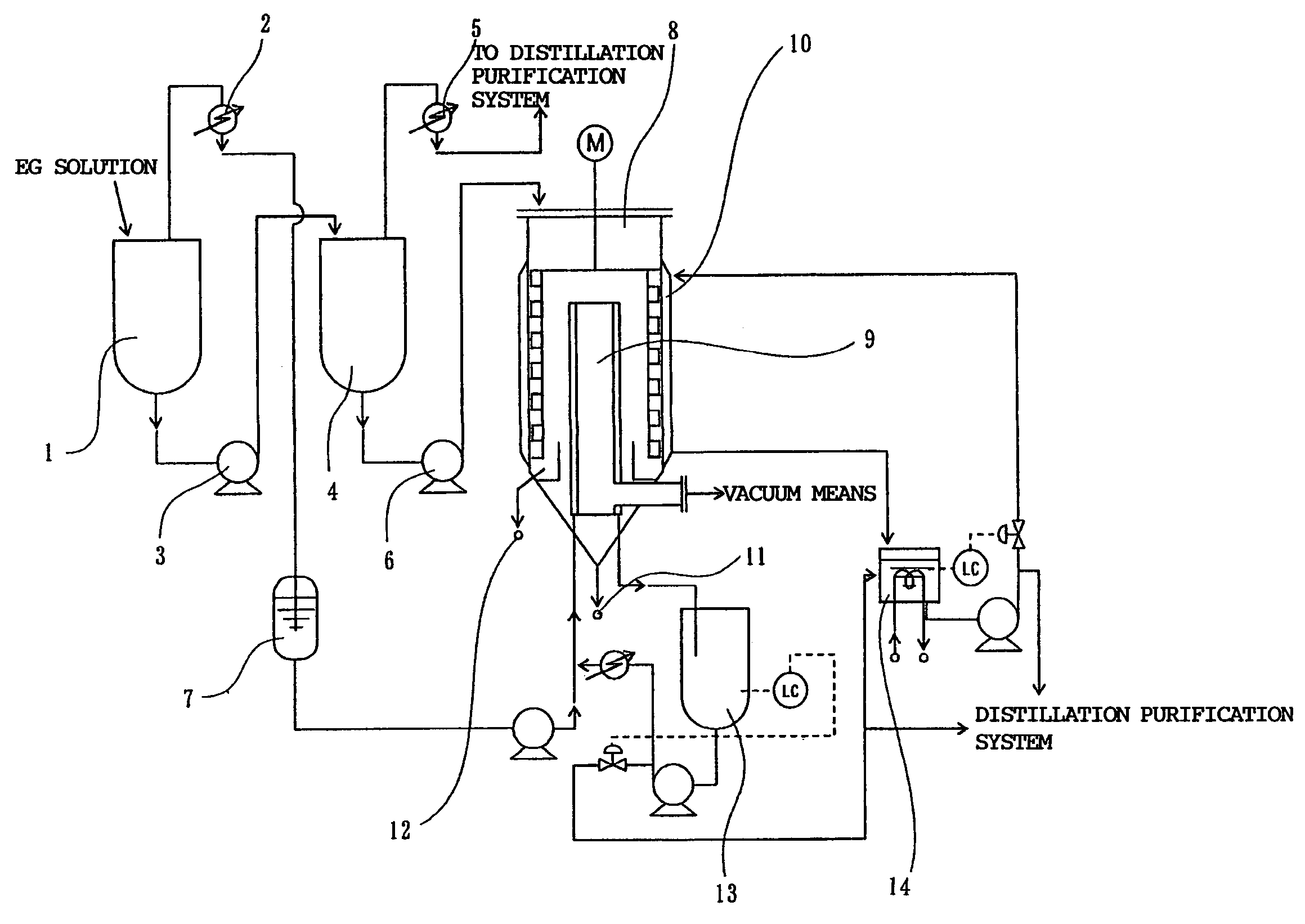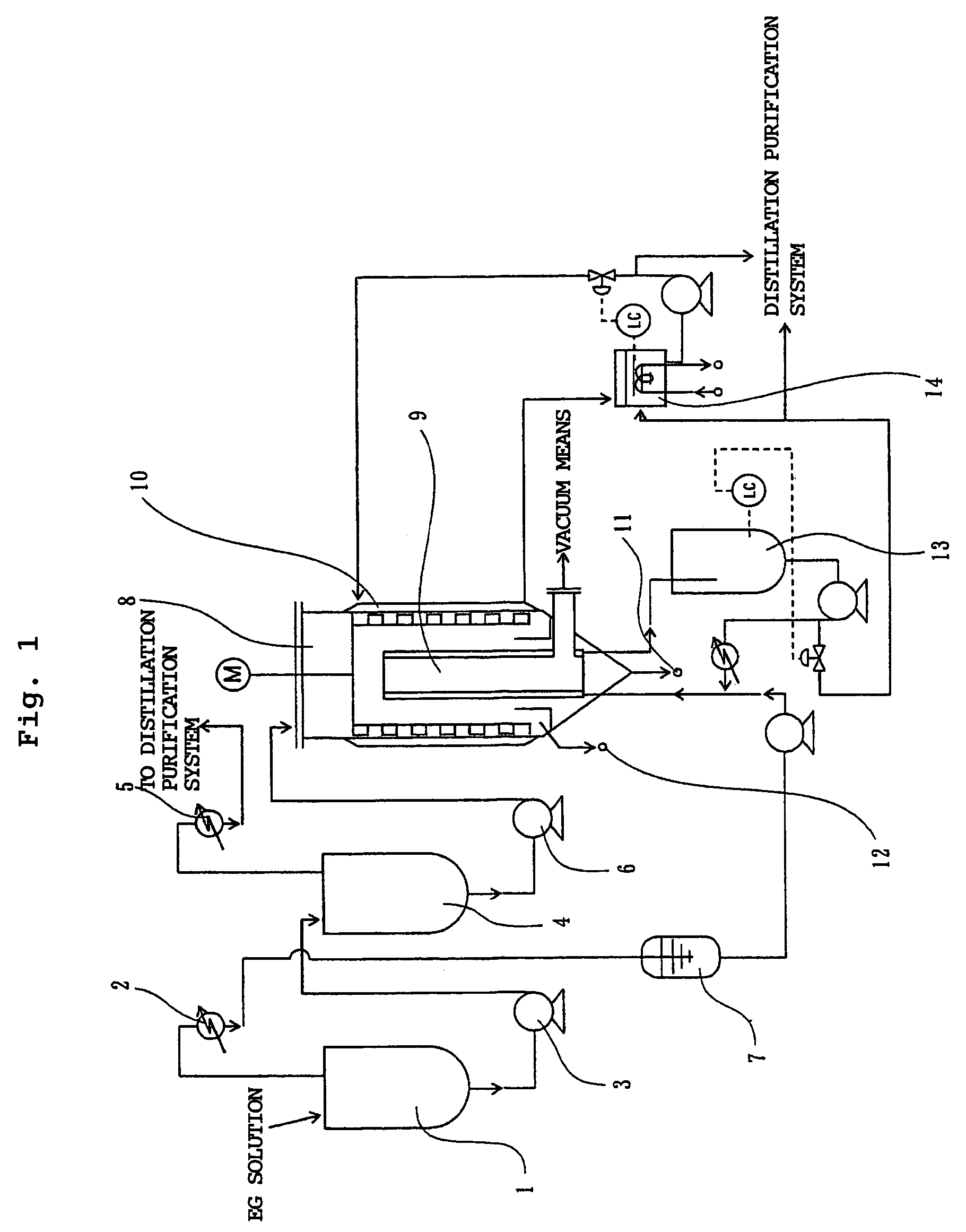Processes for the purification of bis(2-hydroxyethyl)terephthalate
- Summary
- Abstract
- Description
- Claims
- Application Information
AI Technical Summary
Benefits of technology
Problems solved by technology
Method used
Image
Examples
example 1
(Preparation of Starting Material)
(Preliminary Depolymerization)
[0120]57 kg of flakes with an average size of 8 mm×8 mm which had been obtained by crushing and adjusting post-consumer PET bottles (bottles made of a polyethylene terephthalate) mixed with 10 wt % of colored PET bottles and 25 kg of mixture of bis(2-hydroxyethyl)terephthalate(BHET) and an oligomer thereof were charged into an 800-liter autoclave equipped with a stirrer and subjected to preliminary depolymerization under normal pressure at 250° C.
[0121]Then, to the preliminary depolymerization product, 418 kg of ethylene glycol (EG) and 0.23 kg of sodium hydroxide as a depolymerization catalyst were added, and the depolymerization reaction was further promoted at a pressure of 0.15 MPa and a temperature of 220° C. so as to obtain 500 kg of depolymerization reaction solution.
(Removal of Solid Foreign Materials)
[0122]This solution was cooled to 180° C., solid foreign materials (caps, labels, and the like...
example 2
(Preparation of Starting Material)
[0129]A starting material was prepared in the same manner as in Example 1.
(Crystallization Step)
[0130]The crystallization step of Example 1 was repeated except that the crystallization temperature was 15° C. The average particle diameter of a precipitate was 61 μm.
(Solid-Liquid Separation Step)
[0131]A cake was obtained in the same manner as in Example 1.
[0132]As a result, 150 kg (recovery rate: 30 wt %) of the cake containing 61 wt % of crude BHET and 350 kg of (recovery rate: 70 wt %) of filtrate having a solid content of 2.5 wt % were obtained. The content of DEG ester in the cake was 2.3 wt %.
[0133]From these facts, an improvement in crystallization efficiency can be generally expected by lowering the crystallization temperature, and in the present invention as well, the tendency can be seen in the solid contents in the filtrate and cake. At the same time, it was also found that the content of DEG ester which was a content other than BHET in the ...
example 3
(Preparation of Starting Material)
[0142]A starting material was prepared in the same manner as in Example 1. The obtained deionized solution was used as a starting material for purification in the evaporation steps shown in FIG. 1.
(First Evaporation Step)
[0143]The starting material was fed to the first falling-thin-film type evaporator at a feed rate of 138 kg / hr so as to evaporate low-boiling-point components at a temperature of 150° C. and a pressure of 500 Pa. The evaporation treatment time was 3.6 hours. The amount of a first condensate produced by cooling the low-boiling-point components was 109kg / hr. The amount of a produced first melt solution was 29 kg / hr.
[0144]The total content of EG and free DEG and the content of an oligomer in the first melt solution are shown in Table 2.
(Second Evaporation Step)
[0145]Then, the first melt solution was fed to the second falling-thin-film type evaporator at a feed rate of 29 kg / hr so as to evaporate remaining low-boiling-point components a...
PUM
| Property | Measurement | Unit |
|---|---|---|
| Temperature | aaaaa | aaaaa |
| Temperature | aaaaa | aaaaa |
| Temperature | aaaaa | aaaaa |
Abstract
Description
Claims
Application Information
 Login to View More
Login to View More - R&D Engineer
- R&D Manager
- IP Professional
- Industry Leading Data Capabilities
- Powerful AI technology
- Patent DNA Extraction
Browse by: Latest US Patents, China's latest patents, Technical Efficacy Thesaurus, Application Domain, Technology Topic, Popular Technical Reports.
© 2024 PatSnap. All rights reserved.Legal|Privacy policy|Modern Slavery Act Transparency Statement|Sitemap|About US| Contact US: help@patsnap.com









